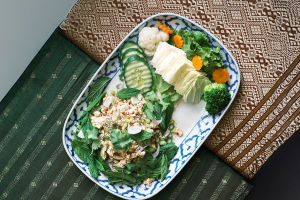When it comes to salads, the dressing can make all the difference. Whether you're preparing a fresh green salad, a hearty pasta salad, or a colorful vegetable medley, the right dressing enhances the flavors and adds that extra zing.
But with so many store-bought options available, how do we choose the best one? And, more importantly, how do we ensure our salad dressings are as healthy as possible?
In this article, we'll explore how to select the right dressing and why making your own can be a healthier choice. Let's dive in!
1. The Basic Types of Salad Dressings
Salad dressings come in all shapes and flavors, but they can generally be divided into two main categories: creamy and vinaigrette.
• Creamy dressings include classics like ranch, blue cheese, and Caesar. These dressings are typically made with a base of mayonnaise or sour cream, giving them a rich and smooth texture. While they're delicious, creamy dressings tend to be higher in calories and lipids.
• Vinaigrette dressings are lighter and often made with a combination of oil (like olive oil), vinegar (such as balsamic or apple cider), and seasonings. Vinaigrettes are generally healthier because they have fewer calories and lipids, especially if you use a healthier oil like extra pure olive oil.
When choosing a dressing, think about the flavors you enjoy most. If you love creamy textures, you might go for ranch or Caesar. But if you're looking to keep it lighter, vinaigrettes are the way to go.
2. Store-Bought vs. Homemade Dressings
Many people rely on store-bought dressings for convenience, and while they are easy to grab off the shelf, they often contain additives, preservatives, and a lot of added sugars. If you check the label, you'll often find ingredients like high-fructose corn syrup, artificial colorings, and excessive salt. These aren't ideal for a healthy diet.
Making your own salad dressing is not only easy but also healthier. Homemade dressings allow you to control what goes in, making it easier to avoid unwanted preservatives and additives. Plus, you can experiment with flavors, create dressings tailored to your taste, and adjust ingredients like oil, vinegar, and herbs to match your dietary needs.
3. Why Homemade Dressings Are Healthier
When we make our own salad dressings, we can choose higher-quality ingredients. For instance, using extra pure olive oil provides heart-healthy fats and antioxidants. You can also use natural sweeteners, like honey or maple syrup, instead of refined sugar. By using fresh herbs and spices, you're adding flavor without extra salt or artificial flavors.
In addition, homemade dressings are free from unnecessary preservatives and stabilizers that are often found in store-bought varieties. So, not only do you get a healthier dressing, but you also avoid the excessive sugars and unhealthy fats commonly found in pre-made versions.
4. Simple and Delicious Homemade Salad Dressings
Let's take a look at some easy-to-make homemade dressings that are both delicious and healthy:
• Classic Balsamic Vinaigrette: Mix 1/4 cup of balsamic vinegar with 3/4 cup of extra pure olive oil, a teaspoon of Dijon mustard, and a pinch of salt and pepper. Shake or whisk it together until well combined.
• Lemon Herb Dressing: Combine 1/4 cup of fresh lemon juice, 1/2 cup of olive oil, 1 teaspoon of honey, a pinch of salt, and a sprinkle of your favorite fresh herbs, like basil or thyme.
• Greek Yogurt Dressing: For a creamy alternative, combine 1/2 cup of Greek yogurt, 1 tablespoon of olive oil, 1 tablespoon of lemon juice, a pinch of garlic powder, and salt to taste. This is a healthier, protein-packed option compared to traditional creamy dressings.
These recipes are incredibly easy to make and can be customized with additional ingredients like garlic, mustard, or different herbs to suit your preferences.
5. Tips for a Healthier Salad Experience
It's not just about the dressing – the other components of your salad matter too! Here are some tips to keep your salad healthy and satisfying:
• Go for a variety of greens: Mix it up with spinach, arugula, kale, and romaine lettuce. Different greens offer different nutrients, and variety helps prevent your salad from becoming too bland.
• Add healthy toppings: Try adding nuts, seeds, or avocado for healthy fats and crunch. You can also toss in some protein like grilled chicken, beans, or tofu.
• Be mindful of portion sizes: While salads are healthy, some toppings (like cheese or croutons) can add extra calories quickly. Be mindful of portion sizes to keep the calorie count in check.
6. Expert Opinion: Balancing Taste and Health
According to nutrition experts, creating a balanced salad means paying attention to both the dressing and the toppings. "When you make your own dressing, you have full control over what you're adding to your salad," says registered dietitian Sarah Smith. "Choosing healthier oils, vinegar, and fresh ingredients allows you to keep the calorie count lower while still enjoying the flavors."
Experts also suggest that a homemade dressing with olive oil can be an excellent source of monounsaturated fats, which are good for heart health. But it's important to keep the oil-to-vinegar ratio in check and not go overboard with the fats.
Conclusion: A Healthier Salad Awaits!
When it comes to salad dressings, homemade is the way to go if you're looking for healthier options. By choosing fresh ingredients and avoiding preservatives and excess sugar, we can create delicious, nutritious dressings that elevate our salads and benefit our health. So, next time you prepare a salad, try making your own dressing and enjoy the fresh, flavorful results. You'll not only feel better, but you'll also love the taste! Happy cooking!


